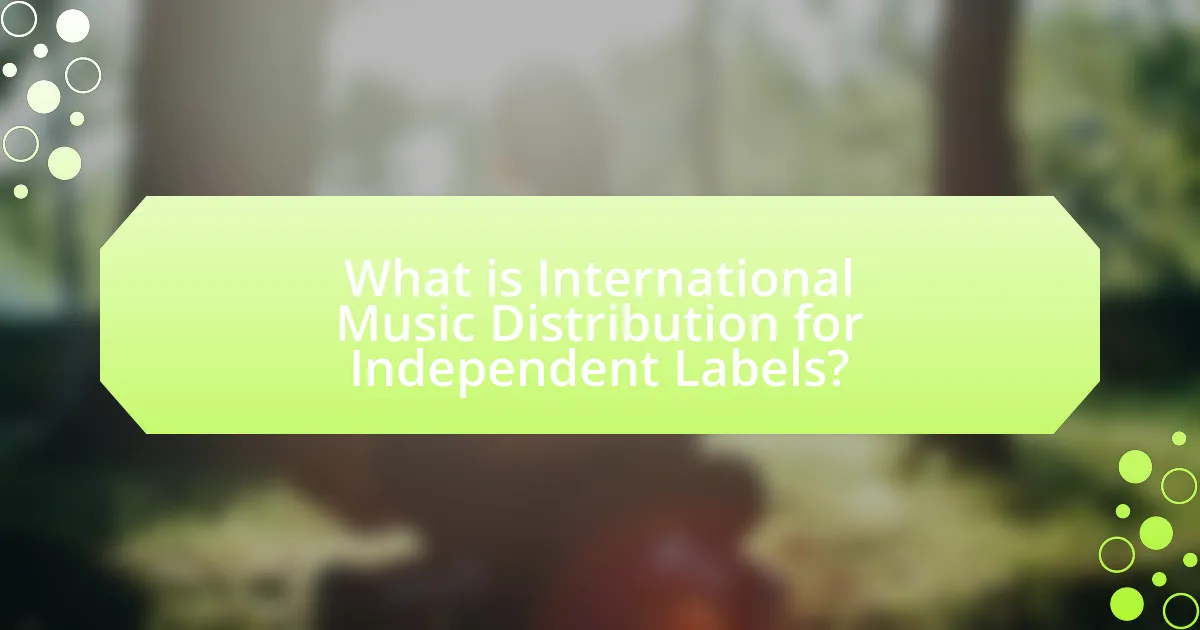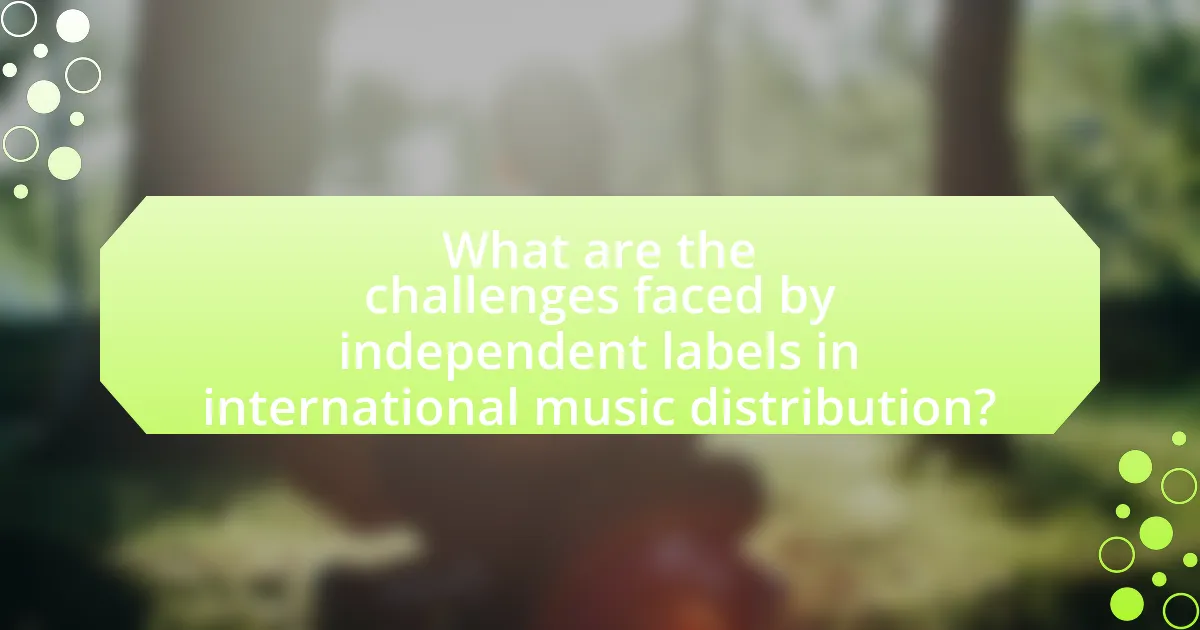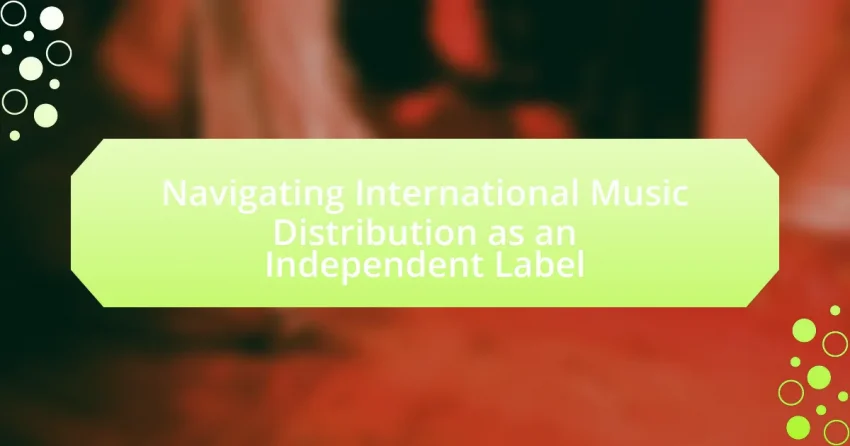International music distribution for independent labels is the process through which these entities distribute their music globally, allowing independent artists to expand their audience and increase revenue. The article outlines the differences between international and domestic distribution, emphasizing the complexities involved, such as navigating legal frameworks and cultural preferences. Key components of successful international distribution include digital platforms, licensing agreements, and targeted marketing strategies. Additionally, the article discusses the challenges independent labels face, including financial constraints and logistical hurdles, while providing strategies for effective distribution and marketing in diverse markets.

What is International Music Distribution for Independent Labels?
International music distribution for independent labels refers to the process by which independent music labels distribute their music to global markets outside their home country. This distribution enables independent artists to reach a wider audience, increase their sales, and enhance their visibility on international platforms. According to the International Federation of the Phonographic Industry (IFPI), independent labels accounted for 39% of global recorded music revenue in 2021, highlighting the significance of effective international distribution strategies for these entities.
How does international music distribution differ from domestic distribution?
International music distribution differs from domestic distribution primarily in its scope and complexity, as it involves navigating multiple legal, cultural, and logistical challenges across various countries. Domestic distribution typically focuses on a single market, allowing for streamlined processes such as licensing, marketing, and sales strategies tailored to local audiences. In contrast, international distribution requires independent labels to understand diverse copyright laws, currency fluctuations, and regional market preferences, which can significantly impact revenue and reach. For example, the global music market generated approximately $23.1 billion in 2020, highlighting the importance of effectively managing international channels to maximize exposure and profitability.
What are the key components of international music distribution?
The key components of international music distribution include digital distribution platforms, licensing agreements, marketing strategies, and royalty collection systems. Digital distribution platforms, such as Spotify and Apple Music, facilitate the global reach of music by providing access to a wide audience. Licensing agreements are essential for ensuring that music can be legally distributed across different territories, often requiring negotiation with local rights holders. Effective marketing strategies are crucial for promoting music in diverse markets, adapting to cultural preferences and trends. Lastly, royalty collection systems ensure that artists and labels receive payment for their work, often involving complex arrangements with various collection agencies worldwide. These components work together to create a comprehensive framework for successfully distributing music on an international scale.
How do different markets influence distribution strategies?
Different markets influence distribution strategies by dictating the channels, pricing, and promotional tactics that independent labels must adopt to effectively reach their target audiences. For instance, in developed markets like the United States and Europe, digital distribution channels such as streaming services are predominant, necessitating a focus on online marketing and partnerships with platforms like Spotify and Apple Music. Conversely, in emerging markets, physical distribution may still play a significant role due to varying internet penetration rates, requiring labels to establish relationships with local distributors and retailers. Additionally, cultural preferences and consumption habits in different regions can shape the types of music promoted and the marketing strategies employed, as seen in the rise of localized content in markets like Latin America and Asia. This adaptability is crucial for maximizing reach and sales in diverse market environments.
Why is international music distribution important for independent labels?
International music distribution is crucial for independent labels because it expands their market reach and increases revenue opportunities. By distributing music internationally, independent labels can access diverse audiences, which is essential for growth in a competitive industry. For instance, according to the International Federation of the Phonographic Industry (IFPI), global recorded music revenues reached $23.1 billion in 2020, highlighting the potential financial benefits for labels that tap into international markets. Additionally, international distribution allows independent labels to build brand recognition and establish partnerships with foreign distributors, further enhancing their visibility and influence in the global music landscape.
What opportunities does international distribution provide for independent artists?
International distribution provides independent artists with access to global markets, allowing them to reach a wider audience and increase their potential revenue streams. By distributing music internationally, artists can tap into diverse fan bases, which can lead to increased sales, streaming, and concert opportunities. For instance, according to a report by the International Federation of the Phonographic Industry (IFPI), global recorded music revenues grew by 7.4% in 2020, driven largely by streaming and international sales. This demonstrates the significant financial potential available to independent artists who engage in international distribution.
How can independent labels leverage international distribution to grow their brand?
Independent labels can leverage international distribution to grow their brand by accessing broader markets and diverse audiences. By partnering with global distribution platforms, independent labels can ensure their music reaches listeners in various countries, increasing visibility and potential sales. For instance, platforms like DistroKid and TuneCore provide access to international streaming services, allowing independent artists to tap into markets that were previously difficult to penetrate. This strategy not only enhances brand recognition but also opens up opportunities for international collaborations and tours, further solidifying the label’s presence in the global music scene.

What are the challenges faced by independent labels in international music distribution?
Independent labels face several challenges in international music distribution, primarily including limited financial resources, lack of market access, and difficulties in navigating complex legal frameworks. Financial constraints hinder independent labels from investing in marketing and promotion, which are crucial for reaching international audiences. Additionally, independent labels often struggle to establish relationships with distributors and retailers in foreign markets, limiting their ability to penetrate those markets effectively. Furthermore, the varying copyright laws and regulations across countries create legal complexities that can impede the distribution process. These challenges are compounded by the dominance of major labels, which can overshadow independent efforts in global markets.
How do legal and regulatory issues impact international distribution?
Legal and regulatory issues significantly impact international distribution by dictating the terms under which products, including music, can be marketed and sold across borders. These issues encompass copyright laws, trade regulations, and compliance with local laws, which can vary widely between countries. For instance, the Berne Convention establishes international copyright standards, affecting how music is protected and distributed globally. Additionally, tariffs and import/export regulations can influence the cost and feasibility of distributing music internationally, as seen in the varying duties imposed by different nations. Compliance with these legal frameworks is essential for independent labels to avoid penalties and ensure successful market entry.
What are the common copyright challenges in different countries?
Common copyright challenges in different countries include varying legal frameworks, enforcement issues, and differing interpretations of copyright laws. For instance, in the United States, the Digital Millennium Copyright Act (DMCA) presents challenges related to online content, while in the European Union, the General Data Protection Regulation (GDPR) complicates copyright enforcement due to privacy concerns. Additionally, developing countries often struggle with inadequate enforcement mechanisms and lack of awareness about copyright laws, leading to widespread piracy. According to the International Intellectual Property Alliance, countries with weak copyright protections experience higher rates of piracy, which undermines the rights of creators and affects revenue for independent labels.
How can independent labels navigate varying distribution laws?
Independent labels can navigate varying distribution laws by thoroughly researching and understanding the legal frameworks in each territory they operate. This involves consulting legal experts familiar with international copyright laws, licensing agreements, and distribution regulations specific to the music industry. For instance, the Berne Convention provides a baseline for copyright protection across member countries, but local laws may impose additional requirements. By leveraging resources such as the International Federation of the Phonographic Industry (IFPI) and regional music industry associations, independent labels can stay informed about changes in legislation and best practices. This proactive approach ensures compliance and maximizes their distribution potential in diverse markets.
What logistical challenges do independent labels encounter?
Independent labels encounter several logistical challenges, including limited resources, distribution complexities, and regulatory hurdles. Limited resources often restrict their ability to invest in marketing, production, and distribution channels, making it difficult to compete with major labels. Distribution complexities arise from the need to navigate various international markets, each with its own distribution networks and consumer preferences. Regulatory hurdles include compliance with different countries’ laws regarding copyright, tariffs, and import/export restrictions, which can complicate the process of getting music to global audiences. These challenges can hinder the growth and reach of independent labels in the competitive music industry.
How does shipping and handling affect international distribution?
Shipping and handling significantly impact international distribution by influencing costs, delivery times, and product integrity. High shipping costs can deter customers and reduce sales, while efficient handling processes ensure timely delivery, which is crucial for maintaining customer satisfaction. For instance, according to the World Bank, logistics costs can account for up to 15% of the total value of goods traded internationally, highlighting the financial implications of shipping. Additionally, improper handling can lead to damage or loss of products, affecting the reputation of independent labels in the competitive music market. Thus, effective management of shipping and handling is essential for successful international distribution.
What role do digital platforms play in overcoming logistical barriers?
Digital platforms play a crucial role in overcoming logistical barriers in international music distribution by providing streamlined access to global markets. These platforms enable independent labels to distribute music efficiently across various regions without the need for physical distribution channels, which can be costly and time-consuming. For instance, services like Spotify and Apple Music allow artists to upload their music and reach audiences worldwide instantly, bypassing traditional barriers such as shipping and inventory management. Additionally, digital platforms often offer analytics tools that help labels understand market trends and consumer preferences, further enhancing their ability to navigate logistical challenges effectively.

What strategies can independent labels employ for successful international music distribution?
Independent labels can employ digital distribution platforms, strategic partnerships, and targeted marketing campaigns for successful international music distribution. Digital distribution platforms like DistroKid and TuneCore enable independent labels to reach global audiences efficiently, allowing for widespread availability of music across various streaming services. Strategic partnerships with local distributors or promoters in target markets can enhance visibility and facilitate entry into new regions, leveraging local expertise and networks. Additionally, targeted marketing campaigns that utilize social media, influencer collaborations, and localized content can effectively engage international audiences, driving streams and sales. These strategies are supported by the growing trend of digital music consumption, which accounted for 62% of global recorded music revenue in 2021, highlighting the importance of effective distribution methods for independent labels.
How can independent labels choose the right distribution partners?
Independent labels can choose the right distribution partners by evaluating their reach, services, and reputation in the industry. First, labels should assess the distribution partner’s ability to access key markets and platforms relevant to their target audience, as a partner with extensive connections can significantly enhance visibility. Additionally, examining the services offered, such as marketing support, royalty management, and data analytics, is crucial, as these can impact the label’s overall success.
Furthermore, researching the partner’s reputation through reviews and case studies can provide insights into their reliability and effectiveness. For instance, a distribution partner with a proven track record of successfully promoting independent artists can be more beneficial than one with limited experience. By focusing on these criteria, independent labels can make informed decisions that align with their goals and enhance their distribution strategy.
What criteria should labels consider when selecting a distributor?
Labels should consider the distributor’s market reach, reputation, and services offered when selecting a distributor. A distributor with extensive market reach can ensure that the label’s music is available in key markets, maximizing exposure and sales potential. The distributor’s reputation is crucial, as established distributors often have better relationships with retailers and streaming platforms, which can facilitate better placement and promotion of the label’s music. Additionally, the services offered, such as marketing support, royalty reporting, and digital distribution capabilities, should align with the label’s needs to ensure effective collaboration and growth.
How can labels build strong relationships with distributors?
Labels can build strong relationships with distributors by establishing clear communication and mutual trust. Effective communication ensures that both parties understand expectations, timelines, and market strategies, which fosters collaboration. Trust is built through consistent performance, transparency in dealings, and honoring agreements, leading to a more reliable partnership. Research indicates that companies with strong supplier relationships experience 20% higher profitability, highlighting the importance of these connections in the music distribution industry.
What marketing strategies are effective for international music distribution?
Effective marketing strategies for international music distribution include leveraging digital platforms, utilizing social media marketing, and engaging in targeted collaborations. Digital platforms such as Spotify and Apple Music enable independent labels to reach global audiences efficiently, as they account for over 80% of music consumption worldwide. Social media marketing allows for direct engagement with fans across different regions, facilitating tailored promotional campaigns that resonate with local cultures. Additionally, collaborations with local artists or influencers can enhance visibility and credibility in specific markets, as evidenced by the success of cross-genre partnerships that have led to increased streaming numbers and fan engagement.
How can social media be utilized to promote music internationally?
Social media can be utilized to promote music internationally by leveraging platforms like Instagram, TikTok, and Twitter to reach global audiences. These platforms allow artists to share their music, engage with fans, and create viral content that can transcend geographical boundaries. For instance, TikTok has been instrumental in launching international hits, with songs like “Old Town Road” gaining massive popularity through user-generated content and challenges. Additionally, social media advertising enables targeted campaigns that can focus on specific demographics in various countries, enhancing visibility and engagement. According to a report by the International Federation of the Phonographic Industry, 79% of music consumers discover new music through social media, highlighting its effectiveness in international music promotion.
What role does local marketing play in international success?
Local marketing is crucial for international success as it enables brands to tailor their strategies to specific cultural, social, and economic contexts of different regions. By understanding local consumer behavior and preferences, businesses can create targeted campaigns that resonate with audiences, leading to increased brand loyalty and sales. For instance, a study by McKinsey & Company found that companies that adapt their marketing strategies to local markets can achieve up to 30% higher revenue growth compared to those that employ a one-size-fits-all approach. This demonstrates that effective local marketing not only enhances brand relevance but also drives overall international performance.
What are the best practices for independent labels in international music distribution?
The best practices for independent labels in international music distribution include establishing strong digital distribution partnerships, understanding local markets, and leveraging social media for promotion. Independent labels should prioritize working with reputable digital distributors like DistroKid or TuneCore, which provide access to global platforms such as Spotify and Apple Music. Understanding local markets involves researching cultural preferences and legal requirements in different countries, which can enhance the label’s ability to tailor marketing strategies effectively. Additionally, utilizing social media platforms like Instagram and TikTok can help independent labels reach international audiences, as these platforms have proven effective in music discovery and fan engagement. According to a report by the International Federation of the Phonographic Industry (IFPI), 70% of music consumers discover new music through social media, highlighting its importance in international distribution strategies.
How can labels effectively track and analyze their distribution performance?
Labels can effectively track and analyze their distribution performance by utilizing data analytics tools and performance metrics. These tools allow labels to monitor sales figures, streaming statistics, and audience engagement across various platforms. For instance, using platforms like Spotify for Artists or Apple Music Analytics provides real-time insights into listener demographics and geographic distribution, enabling labels to assess which markets are performing well. Additionally, tracking key performance indicators (KPIs) such as revenue per release, return on investment (ROI) for marketing campaigns, and audience growth rates offers concrete data to evaluate distribution strategies. By analyzing this data, labels can make informed decisions to optimize their distribution efforts and enhance overall performance.
What common pitfalls should independent labels avoid in international distribution?
Independent labels should avoid several common pitfalls in international distribution, including lack of market research, inadequate legal understanding, and poor communication with partners. Conducting thorough market research is essential to identify target audiences and local trends, as failure to do so can lead to ineffective marketing strategies. Additionally, understanding international copyright laws and distribution agreements is crucial; neglecting this can result in legal disputes and financial losses. Lastly, maintaining clear and consistent communication with distributors and partners across different regions is vital to ensure alignment and avoid misunderstandings that could hinder distribution efforts.
What practical tips can independent labels implement for successful international distribution?
Independent labels can implement several practical tips for successful international distribution, including establishing partnerships with local distributors, utilizing digital platforms, and understanding regional markets. Forming partnerships with local distributors allows labels to leverage existing networks and expertise in specific regions, enhancing their reach and effectiveness. Utilizing digital platforms like Spotify, Apple Music, and Bandcamp enables independent labels to distribute music globally with minimal overhead costs, as these platforms have established user bases and distribution channels. Understanding regional markets involves researching cultural preferences, legal requirements, and promotional strategies that resonate with local audiences, which can significantly improve the chances of success in those markets.
